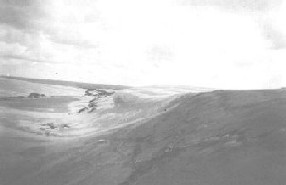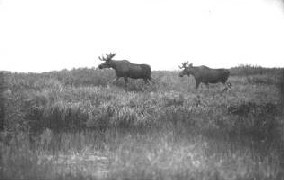Landscape
Road between Rossitten and Nidden
(V. Moslehner © Brigitte Bean)
The Courland Spit has about a hundred kilometres in length and between 0, 4 and 4 kilometres in width. On the spit used to be a high forest, but is has been cut down, just near Schwarzort a small area had remained. To pave the dunes special pines from Thuringia has been planted, that are now accounting for a major part of the vegetation. There are areas with small bushes and a vegetation similar to heath, which is called "Palwe" - a regional and probably Curanian notation. Near the banks of the Lagoon there were often found small lakes and some wetland-areas.
The dunes
 The
highest
dunes in Europe were located on the spit. They are still shifting today.
Just a little bit indeed, for the biggest part the dunes are paved. Till
the late 19th century whole villages on the spit had felt victim to the
shifting dunes. The sand needed almost 42 years to cover Pillkoppen completely,
but in 1839 the village had to be abandoned. Negeln had been the last settlement
on the spit lost to the shifting masses of sand in 1854. Although the paving
of the dunes started early, some planting experiments were needed to find
a proper method. First they tried to prepare the dunes with cropped sand
grass before small pines were planted, but this way turned out to be too
slow. A plantation inspector called Ephra - after whom a hill near Nidden
has been named later - experimented successfully with forest pines from
Thuringia that were planted in squares stacked with timber and filled with
brushwood and some dredging sludge on top. This solved at the end one of
their problems, the other was to prevent the sea from banking up more sand.
So fore dunes were created with brushwood fences along the shore, holes
were filled and high sand peaks were removed. And last but not least the
dunes could be pacified.
The
highest
dunes in Europe were located on the spit. They are still shifting today.
Just a little bit indeed, for the biggest part the dunes are paved. Till
the late 19th century whole villages on the spit had felt victim to the
shifting dunes. The sand needed almost 42 years to cover Pillkoppen completely,
but in 1839 the village had to be abandoned. Negeln had been the last settlement
on the spit lost to the shifting masses of sand in 1854. Although the paving
of the dunes started early, some planting experiments were needed to find
a proper method. First they tried to prepare the dunes with cropped sand
grass before small pines were planted, but this way turned out to be too
slow. A plantation inspector called Ephra - after whom a hill near Nidden
has been named later - experimented successfully with forest pines from
Thuringia that were planted in squares stacked with timber and filled with
brushwood and some dredging sludge on top. This solved at the end one of
their problems, the other was to prevent the sea from banking up more sand.
So fore dunes were created with brushwood fences along the shore, holes
were filled and high sand peaks were removed. And last but not least the
dunes could be pacified.
The Elks

Heath land areas with willows, alders, birches and small pools
and lakes at the banks of the lagoon were a perfect habitat for the elks.
On the mainland across the lagoon a region called "Elchrevier - Elk
Lowlands" indicated that also on the other side of the lagoon elks
were indigenous. Elks are good swimmers and they even crossed the lagoon
at narrow spots. In the summer when it gets really hot, they like to take
a refreshing bath in the Baltic Sea. Some summer guests left descriptions
of very surprising encounters at the beach in Nidden.
In 1940 about 150 elks lived on the spit, thereof 50 bull elks. Near Nidden was an elk territory and the visitors were driven by pony carriages to catch a glimpse of one of the big animals.